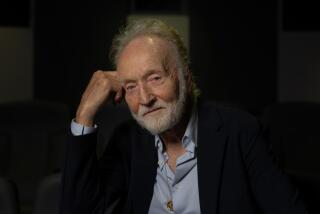Still Abuzz Over ‘Chainsaw’ : Fan Expo Brings Out Crowd of Grisly Film’s Aficionados
- Share via
When he was working on the 1974 splatterfest “The Texas Chainsaw Massacre,” Edwin Neal, at that time a self-described “serious actor,” told his friends, “ ‘It’s a good thing I don’t have to tell anyone in my family about this.’ ”
Today, the movie is a cottage industry commemorating its 20th anniversary, and his kids take him to school for show and tell.
Neal, who played the wacked-out hitchhiker whose creepy relatives took their family slaughterhouse business public, sits alongside four other members of the original cast at a booth at Glendale Civic Auditorium, the site this past weekend for a cultural event dubbed “Horri Fi 1.” The cast members have been meeting under similar circumstances with surprising regularity over the years.
Shot for $140,000, “The Texas Chainsaw Massacre” made approximately $25 million upon its initial release. Tobe Hooper’s directorial debut effort is considered a classic of its genre, paving the way, for better or worse, for all the titillating yet bizarrely moralistic horror fables in which teens with dubiously set moral compasses receive grisly punishments far exceeding the gravity of their misdeeds.
At this fan expo, vendors and patrons haggle over the prices of old copies of Famous Monsters of Filmland; a guy in an Elvira T-Shirt loudly describes some forgotten classic in which someone’s blood and brains ran copiously from his ears; busty, fright-flick survivors sit around peddling glossy publicity stills. Hard-core fans pay to have their picture taken wearing Leatherface’s original butcher apron. A booth selling horror videocassettes serenades the “Chainsaw” cast from across the aisle with what Marilyn Burns, who starred as Sally, the sole survivor of the ordeal, estimates is the seventh replay of “Massacre” today.
A doting fan tries to flirt with Burns: “You’re just as lovely as you were 20 years ago.”
Burns laughs off the compliment, referring to a couple of publicity stills depicting her shrieking and drenched in bright red Karo syrup.
“The way I looked in ‘Texas Chainsaw Massacre,’ I never saw such nasty faces in my life. I figure, 20 years later, I can’t lose. Compared to that, how can I possibly worry about how I look now?”
People seriously hung up on “Chainsaw” aren’t like other people, and Neal and Burns accept their adulation with cheery bemusement. “We sign chain saws, we sign body parts--people ask me to sign their arm, then they go to a tattoo parlor and have them tattoo my autograph,” Neal says. “I ask them, ‘What if, in a couple of years, you decide you don’t like the movie anymore?’ and they say, ‘Never!’
“Some of these people don’t exist outside of these shows,” jokes Neal, who still acts and produces in Austin, Tex. “They’re trucked in from someplace just to these shows, then when they’re over, they’re herded back into trucks and taken back to wherever. This is the only place you see these kind of people--this and Hollywood Boulevard.”
Burns, who still acts in theater and films in Houston, recalls how physically demanding the role was. “That bruise on my face matched in continuity all through the picture because it was real.
“Then there was this scene where I was running through smoke and falling down. We were up to Take 48, and only around Take 30 did it occur to someone to say, ‘Hey, she’s bleeding; maybe she needs some kneepads.’ . . . When they cut my finger, they forgot to tape up the knife edge. . . . They made me jump off a scaffolding. I hurt my leg--that limping at the end of the movie wasn’t acting.”
Jim Siedow, who retired six years ago in Houston from a life of acting and making commercials, got the gig as the Old Man to appease a union regulation. “I was the one SAG (Screen Actors Guild) actor. I was only there one week, and that week almost killed me.”
John Dugan, who portrayed the grandfather who still harbored a little bit of blood lust, if not much life, had a similarly unpleasant experience. “I had a pound of liquid latex makeup on my head, and I just kind of zoned out. You can only be extremely uncomfortable for so long before your mind goes elsewhere. We shot for 26 hours, and when they finally pulled the mask off, all the blood had drained out of my head.”
The woes continued upon the film’s release--it was assailed for its graphic nature. “There was all this horrible press, that we actually killed someone during the movie. But the bodies in the movie were brought in from India--at that time, you could buy human bodies and legally bring them into the country,” Neal explains.
Yet many reviews were positive. “I had little faith in it,” recalls Dugan, who today works on industrial films in Indiana. “But I remember when Roger Ebert reviewed it, he compared me to Dustin Hoffman in ‘Little Big Man’ . . . I thought, maybe there is something to this film.”
Gunnar Hansen, who essayed the immortal role of Leatherface, the psychopathic, chain saw-wielding anti-hero for a disaffected generation, left Texas soon after the film wrapped to write in Maine. “I thought it would maybe win a small cult of fans, like ‘Two Thousand Maniacs.’ A couple of years later, I came out to L.A. and discovered while I was living this very different life in Maine, the picture was becoming more and more famous, and I had become this mystery man.”
Across the way, the videocassette booth has replaced “Chainsaw” with a cheesy version of “Dracula” starring Jack Palance. “Did they finally change the movie?” Burns asks. “Thank God.”
More to Read
Only good movies
Get the Indie Focus newsletter, Mark Olsen's weekly guide to the world of cinema.
You may occasionally receive promotional content from the Los Angeles Times.










